Hosting a tea tasting party offers a unique and engaging way to expand your palate, discover new flavors, and foster social connections. You'll enhance your knowledge of tea culture while boosting your hosting confidence with this simple yet sophisticated event format. By selecting a variety of quality teas, setting the perfect ambiance, and mastering tasting techniques, you'll create a memorable experience for your guests. You can pair teas with complementary snacks, create custom blends, and organize fun activities to keep everyone engaged. With the right equipment and a little preparation, you'll be well on your way to becoming a tea party pro.
Benefits of Tea Tasting Parties
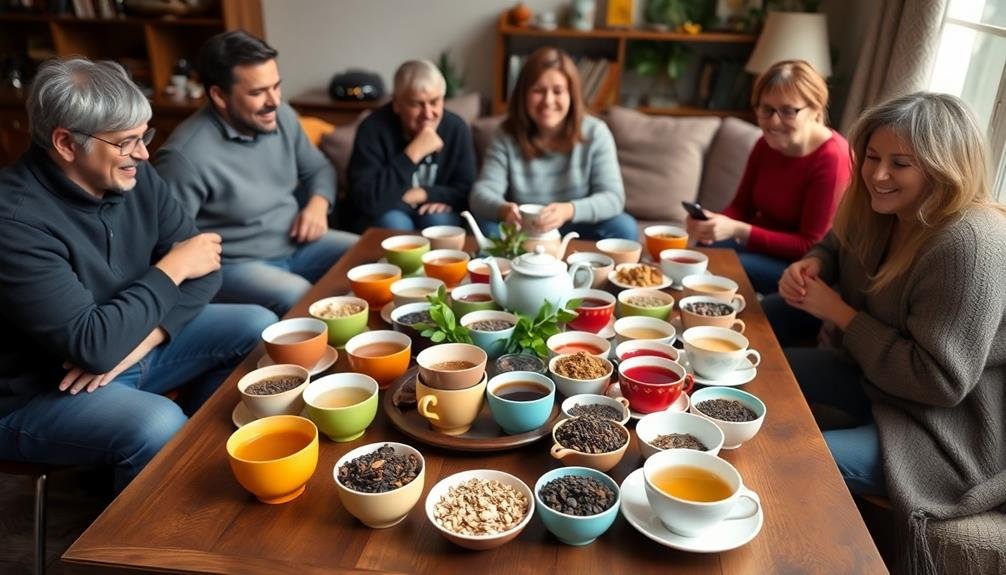
Tea enthusiasts and novices alike can reap numerous rewards from hosting or attending a tea tasting party. You'll expand your palate and discover new flavors you might've otherwise overlooked. By sampling various teas side-by-side, you'll develop a keener sense of taste, learning to distinguish subtle notes and nuances in different blends.
These gatherings offer a unique social experience, fostering connections and sparking engaging conversations. You'll share knowledge with fellow tea lovers, exchanging tips on brewing techniques, tea origins, and health benefits. It's an excellent opportunity to learn about tea culture and history, enhancing your appreciation for this ancient beverage.
Hosting a tea tasting party can boost your confidence in entertaining, as it's a relatively simple yet sophisticated event to organize. You'll hone your hosting skills while creating a relaxed, enjoyable atmosphere for your guests. Additionally, these parties can be a cost-effective alternative to traditional dinner parties or nights out, offering a refined experience without breaking the bank.
Lastly, tea tasting parties promote mindfulness and relaxation. The act of savoring each sip encourages you to slow down, be present, and fully appreciate the moment.
Selecting Teas for Your Event
When selecting teas for your tasting event, focus on variety and quality. Choose 4-6 different types of tea to showcase diverse flavors and aromas. Include classics like black, green, oolong, and white teas, but don't shy away from unique blends or herbal infusions. Consider teas from various regions to highlight geographical differences.
Opt for loose leaf teas over tea bags for a more authentic experience. Look for reputable tea shops or online retailers that offer high-quality, fresh teas. Pay attention to harvest dates and storage conditions to guarantee peak flavor. If possible, sample the teas yourself before the event to gauge their taste profiles.
Consider your guests' preferences and experience levels when making selections. Include a mix of familiar and adventurous options to cater to different palates. If you're unsure, consult with a tea expert or shop owner for recommendations.
They can help you create a well-rounded selection that'll appeal to both novices and connoisseurs alike. Remember, the goal is to provide an engaging and educational experience that introduces your guests to the wide world of tea.
Essential Equipment and Supplies
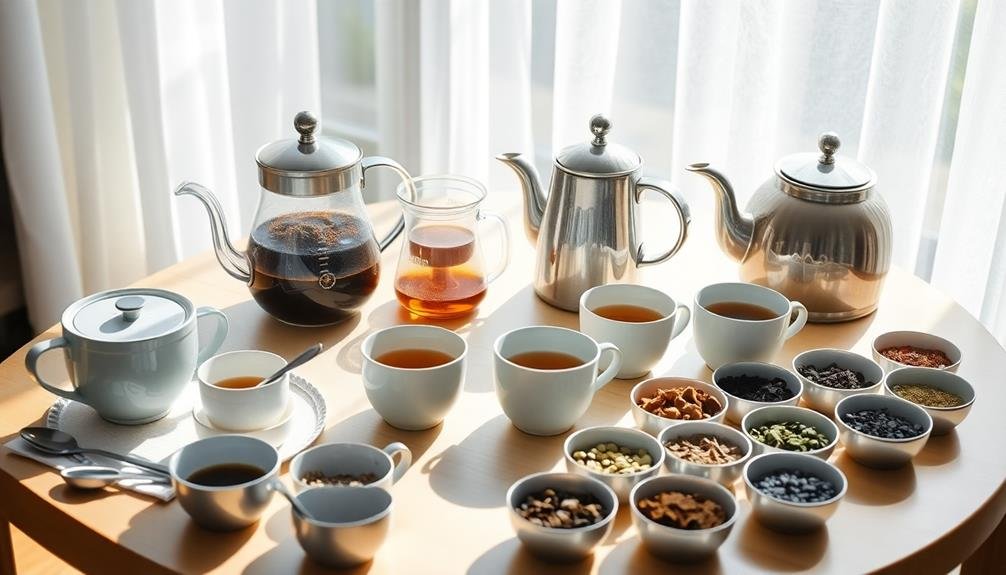
In order to host a successful tea tasting party, you'll need to gather the right equipment and supplies. Start with a quality electric kettle that allows you to control water temperature precisely, as different teas require specific brewing temperatures. Invest in a timer to guarantee proper steeping times for each variety.
For serving, you'll want a selection of teapots or gaiwans, along with matching cups or tasting sets. Choose small cups to allow for multiple tastings without overwhelming your guests. Don't forget about strainers or infusers for loose leaf teas.
Provide small plates for used tea leaves and spoons for transferring leaves. A pitcher of room temperature water and rinse bowls are essential for cleansing palates between tastings. Consider having notepads and pens available for guests to jot down their impressions.
For presentation and education, prepare tasting note cards describing each tea's origin, flavor profile, and brewing instructions. A tea flavor wheel can be a helpful visual aid for guests to identify and articulate flavors.
Setting the Perfect Ambiance
As you plan your tea tasting party, don't overlook the importance of ambiance in enhancing the experience.
You'll want to contemplate the lighting and mood, your décor and table settings, and even the music or background sounds.
These elements work together to create an atmosphere that complements the teas and encourages guests to fully immerse themselves in the tasting journey.
Lighting and Mood
Creating the right ambiance is essential for a successful tea tasting party. Lighting plays a significant role in setting the mood and enhancing the overall experience. You'll want to strike a balance between functionality and atmosphere, ensuring your guests can see their tea clearly while still feeling relaxed and comfortable.
Opt for soft, warm lighting that creates a cozy and inviting atmosphere. Natural light is ideal if you're hosting during the day, but if that's not possible, consider using:
- Dimmable overhead lights to adjust brightness as needed
- Table lamps or candles for a gentle, diffused glow
- String lights or lanterns for a whimsical touch
Avoid harsh fluorescent lighting, as it can alter the perception of tea colors and create an uninviting environment. Instead, aim for a warm color temperature around 2700-3000K, which mimics the golden hour of sunlight and complements the rich hues of various teas.
Remember that lighting isn't just about visibility; it's about creating an emotional connection to the space. By carefully considering your lighting choices, you'll set the stage for a memorable and enjoyable tea tasting experience for your guests.
Décor and Table Settings
With the right lighting in place, your attention can now turn to the overall décor and table settings for your tea tasting party. Choose a color scheme that complements your tea selections and creates a cohesive atmosphere. Opt for neutral or pastel tones to keep the focus on the teas themselves.
For your table, use a crisp, white tablecloth as a clean backdrop. Set out small plates, teacups, and saucers for each guest. Include teaspoons, sugar bowls, and milk jugs as needed. Place tasting note cards and pens at each setting to encourage guests to record their impressions.
Incorporate natural elements like fresh flowers or potted herbs as centerpieces. These can add a subtle fragrance without overpowering the tea aromas. Consider using tea-themed decorations, such as vintage teapots or tea tins, to enhance the ambiance.
Don't forget practical elements like water pitchers for rinsing between tastings and spittoons for those who prefer not to swallow every sample.
Arrange your teas in a logical order, from lightest to darkest, and label each variety clearly. This attention to detail will guarantee a smooth and enjoyable tasting experience for your guests.
Music and Background Sounds
The gentle clink of teacups and soft murmur of conversation aren't the only sounds that'll enhance your tea tasting party. Carefully chosen background music can set the perfect mood and complement the tasting experience.
Opt for soothing, instrumental tracks that won't overpower the delicate flavors of the teas or distract your guests from their sensory journey.
Consider these three elements when selecting music for your tea tasting party:
- Tempo: Choose slower, calming rhythms that encourage relaxation and mindfulness.
- Volume: Keep it low enough to allow easy conversation and focus on the teas.
- Genre: Classical, ambient, or traditional music from tea-producing regions can create an appropriate atmosphere.
Nature sounds can also provide a serene backdrop. The gentle patter of rain, rustling leaves, or a babbling brook can transport your guests to a tranquil tea garden.
If you're hosting an outdoor event, embrace the natural ambient sounds around you. Remember, the goal is to create an environment that enhances the tea-tasting experience without overwhelming it.
Let the music and sounds complement the aromas and flavors, creating a multi-sensory journey for your guests.
Tasting Techniques and Etiquette
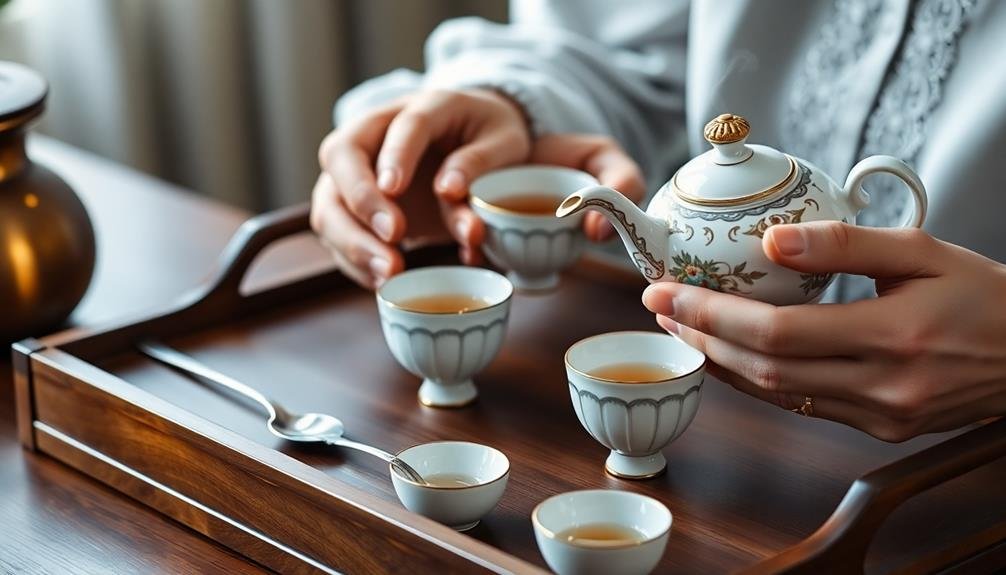
Mastering the art of tea tasting requires proper techniques and etiquette. Start by observing the dry tea leaves, noting their color, shape, and aroma.
When steeping, pay attention to the recommended temperature and time for each tea variety. As you pour, listen to the sound and watch the color of the liquid.
Before sipping, take in the tea's aroma by gently swirling the cup and inhaling deeply.
When tasting, slurp the tea to aerate it and spread it across your palate. This allows you to detect subtle flavors and nuances. Take small sips and let the tea linger in your mouth before swallowing.
Consider the tea's body, flavor profile, and aftertaste. Cleanse your palate between different teas with water or neutral crackers. It's polite to use the provided spittoon if you don't want to swallow every sip.
When discussing the teas, be respectful of others' opinions and avoid dominating the conversation.
Take notes if you'd like, but don't let it distract from the social experience. Remember, tea tasting is about enjoyment and learning, so relax and savor the moment.
Pairing Teas With Snacks
Pairing teas with the right snacks can elevate your tea tasting experience to new heights. When selecting snacks, consider the flavor profile of each tea and choose complementary foods that won't overpower the tea's delicate notes. Light, neutral-flavored snacks work well with most teas, allowing guests to cleanse their palates between tastings.
For a successful tea and snack pairing, follow these guidelines:
- Match intensity: Pair delicate teas like white or green with mild snacks such as cucumber sandwiches or plain shortbread cookies. Robust teas like black or pu-erh can handle stronger flavors like cheese or dark chocolate.
- Consider flavor notes: Choose snacks that share similar flavor characteristics with the tea. For example, pair a fruity oolong with dried fruit or a smoky Lapsang Souchong with smoked salmon.
- Balance textures: Contrast the tea's mouthfeel with different textures in your snacks. Pair creamy teas with crunchy nuts or crisp crackers, while light teas can be balanced with soft, delicate pastries.
Remember to offer a variety of snacks to accommodate different tastes and dietary restrictions. With thoughtful pairings, you'll create a memorable and enjoyable tea tasting experience for your guests.
Creating Custom Tea Blends

After exploring various teas, you might want to try your hand at creating custom tea blends. This activity can be a fun and engaging part of your tea tasting party. Start with a base tea, such as black, green, or white tea, and experiment with adding different herbs, spices, or dried fruits.
Consider popular combinations like Earl Grey (black tea with bergamot oil) or chai (black tea with warming spices).
When blending, use a ratio of about 70% base tea to 30% additional ingredients. Mix small batches first to perfect your recipe before scaling up. Be mindful of flavor intensity; some ingredients, like mint or cinnamon, can easily overpower others.
Keep notes on your experiments to replicate successful blends.
Encourage your guests to create their own unique blends. Provide a variety of base teas and mix-ins, along with small bags or tins for them to take their creations home.
This hands-on activity not only educates participants about tea components but also allows them to personalize their tea experience. Don't forget to name your custom blends – it adds a personal touch and makes the experience more memorable.
Engaging Activities for Guests
To keep your tea tasting party lively and interactive, incorporate engaging activities for your guests. Start with a blind tasting challenge where you cover tea labels and have participants guess the varieties. This sharpens their senses and sparks friendly competition.
Next, introduce a tea and food pairing activity. Provide small bites like chocolates, cheeses, or pastries, and let guests discover which flavors complement different teas best.
For a creative twist, set up a tea-inspired art station. Offer watercolors and paper, encouraging guests to paint using various teas as their medium. This activity showcases tea's versatility beyond drinking and creates unique take-home mementos.
To structure your party, consider these key activities:
- Tea trivia quiz with prizes for the most knowledgeable participants
- Guided tea meditation session for a calming interlude
- Tea leaf reading workshop to explore the mystical side of tea culture
These activities not only entertain but also educate your guests about tea's rich history and cultural significance.
Post-Party Tea Storage Tips
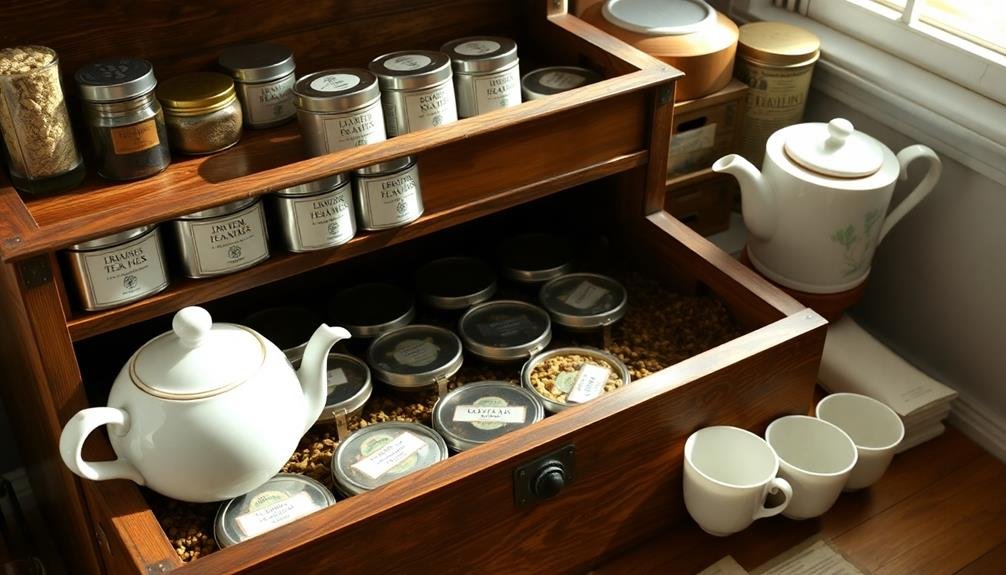
Once your tea tasting party wraps up, you'll need to properly store any leftover teas to maintain their freshness and flavor.
Start by sorting your teas into their respective categories: black, green, oolong, white, and herbal. Each type requires specific storage conditions to preserve its unique characteristics.
Keep your teas in airtight containers to prevent moisture and odors from affecting their quality. Opt for opaque containers or store them in a dark place, as light can degrade tea leaves over time.
Avoid plastic containers, as they can impart unwanted flavors; instead, choose glass, ceramic, or metal options.
Store your teas in a cool, dry place away from heat sources and strong odors. The ideal temperature range is between 60-70°F (15-21°C).
Avoid refrigerating or freezing your teas, as this can introduce moisture and compromise their flavor.
For best freshness, consume your teas within six months to a year. Green and white teas are more delicate and should be consumed sooner, while black teas and pu-erh can be aged for longer periods.
Frequently Asked Questions
How Many Guests Are Ideal for a Tea Tasting Party?
You'll want to keep your tea tasting party intimate. Aim for 6-10 guests, as this allows everyone to participate actively, share opinions, and sample different teas without feeling overwhelmed. It's perfect for meaningful conversation and enjoyment.
Can I Host a Tea Tasting Party Outdoors?
Yes, you can absolutely host a tea tasting party outdoors! It's a great way to enjoy nature while sipping your favorite brews. Just be mindful of the weather and have a backup plan in case of unexpected rain.
How Long Should a Tea Tasting Party Typically Last?
You'll want to plan for your tea tasting party to last about 2-3 hours. This gives you enough time to sample several teas, discuss flavors, and enjoy light snacks without overwhelming your guests' palates or schedules.
Are There Any Teas to Avoid Serving at a Tasting Party?
You'll want to avoid serving low-quality or stale teas at your tasting party. Skip overly flavored or artificial blends, as they can overpower subtle notes. Stick to fresh, high-quality teas that showcase diverse flavors and aromas.
Should I Provide a Spittoon for Guests Who Don't Want to Swallow?
You should provide a spittoon for your tea tasting party. It's considerate for guests who want to taste without swallowing. You'll give them the option to fully experience each tea's flavor without overconsuming or feeling uncomfortable.
In Summary
You've now got all the tools to host an unforgettable tea tasting party. Don't be afraid to get creative and make it your own. Remember, it's about sharing your passion for tea and creating memorable experiences with friends. As you explore new flavors and blends, you'll deepen your appreciation for this ancient beverage. So go ahead, send out those invitations, and let the steeping begin! Your journey into the world of tea awaits.

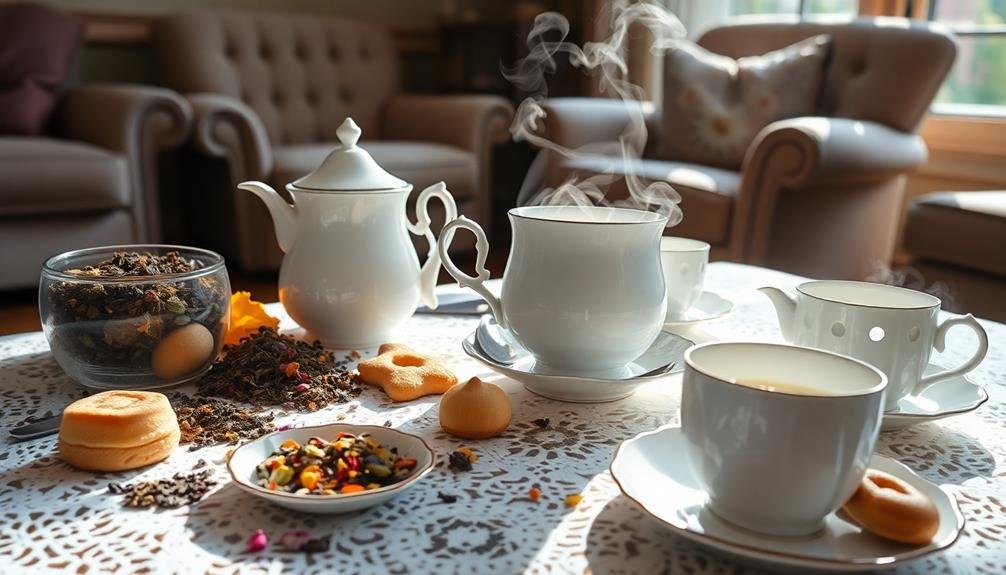
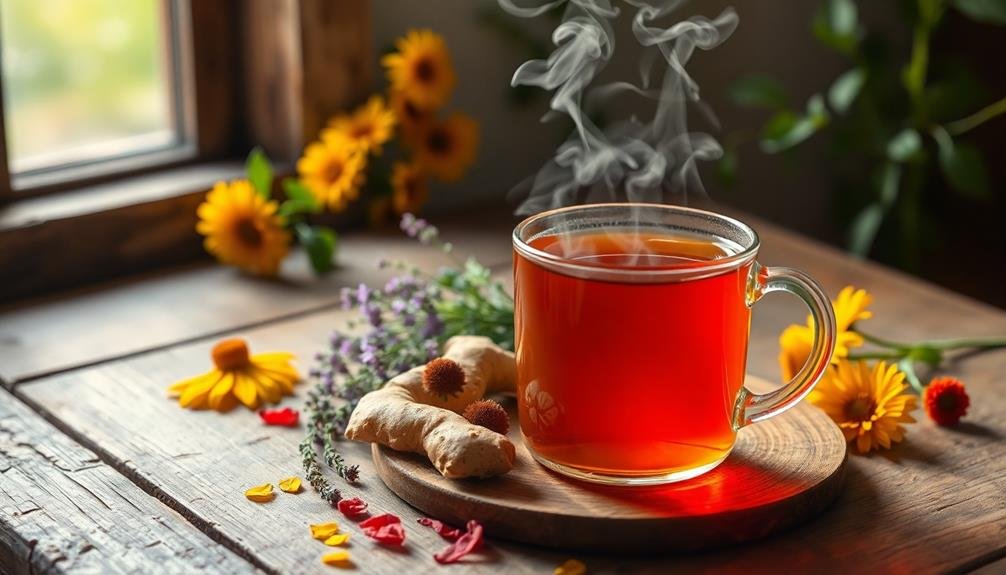
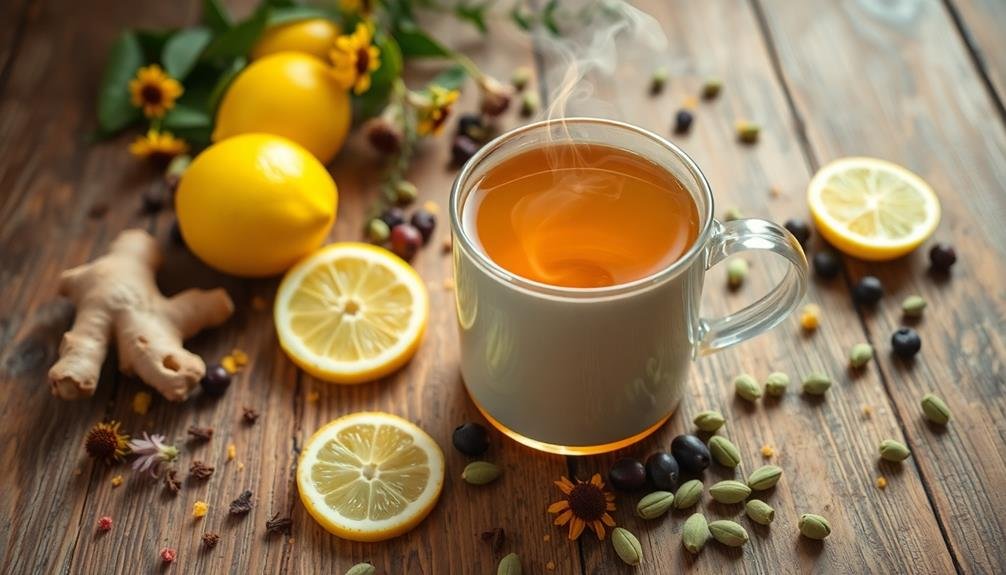

Leave a Reply